
350 Words for Jewellery isn’t the kind of a book you’d bring on vacation. Instead, jewelry designer and researcher Barbara Schmidt’s deliberate prose leads the reader on an intellectually stimulating journey that roams broadly through the expansive world of jewelry.[i] Referencing 75 different languages, Schmidt follows the deep connection of jewelry to all aspects of human history, with Neanderthals, Ancient Greek and Egyptians, and more modern cultures making appearances. By examining the origins of words for jewelry, the book invites a multi-layered perspective for understanding what jewelry is and why we, as humans and as jewelry lovers, are so drawn to it.
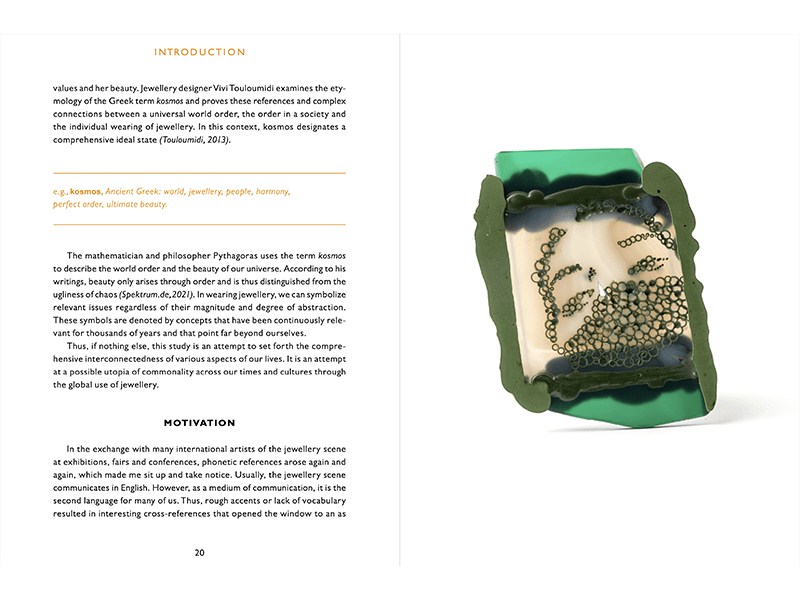
The term “art jewelry” confounds simple definitions. Enthusiasts and collectors alike are flummoxed by the lack of consensus around what exactly is included in this vague category. Author jewelry, craft jewelry, studio jewelry, contemporary jewelry, and art jewelry (the preferred usage by this platform) represent more or less the same thing, with minute differences. Other books have addressed this conundrum: Liesbeth den Besten’s 2011 book On Jewellery: A Compendium of International Contemporary Art Jewellery and Kellie Riggs’s 2013 article “What Is It that You Do Exactly?”[ii] both attempt to clarify the complexity of the term and the resulting objects, which also defy simple definitions.

Schmidt rightly points out that naming a thing is the first step to understanding it. Within the context of Art Jewelry Forum’s 25th anniversary year, this book introduces how culturally relevant jewelry is to humans, now and in past millennia. It supports the very reason that art jewelry exists as a field of creative research and study, which is to explore, question, and challenge the meaning of jewelry through and across culture.

Structurally, 350 Words for Jewellery is broken up into chapters and then titled subsections that ease and coax the reader through the book. Each chapter heading is a single word— “Introduction,” “Language,” “Scripture,” “Symbol,” “Impact,” “Composition,” “Perception,” and “Thanks”—followed by a simple phrase alerting the reader to the content. So, the subheading for the chapter called “Language” is “Whoever wears jewelry has something to say.” The chapter subsequently explains how jewelry and language are connected, how jewelry speaks without words, how jewelry and writing are connected, and many other fascinating connections between jewelry and language.
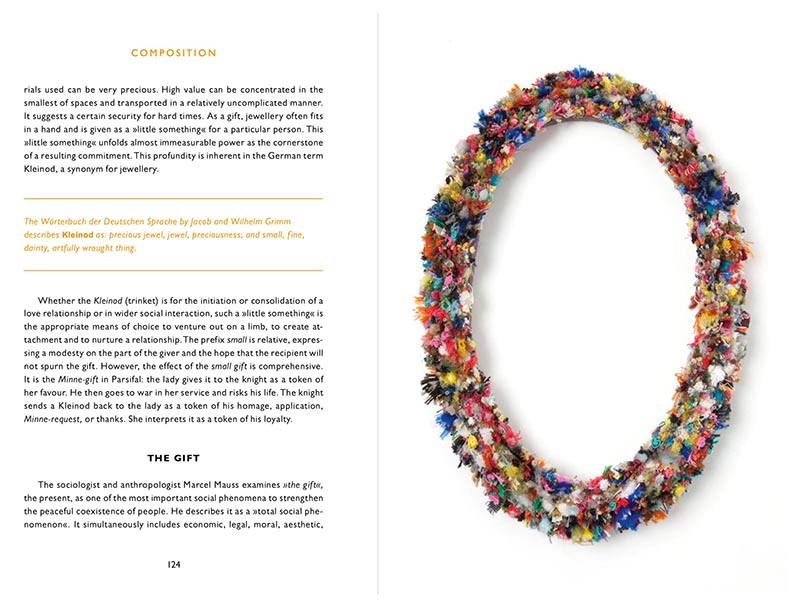
To support these ideas, the text features the voices of many experts, from archaeology, anthropology, sociology, psychology, ethnology, and every other -ology imaginable, to explain and contextualize jewelry across culture and history. Wonderfully, jewelry artists are also included in these expert voices, sharing their research through images and artist statements, as well as inline quotes and references from their publications.
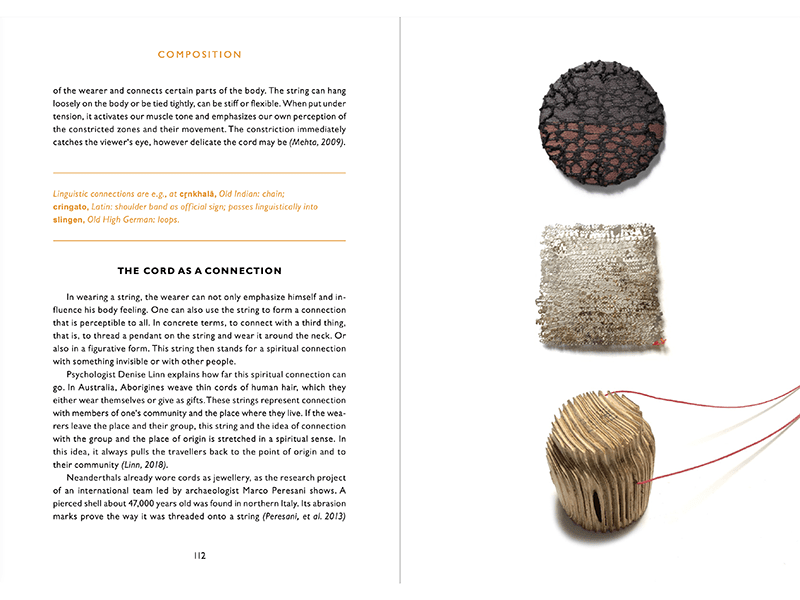
The “Perception” chapter includes the voices of Indologist Jutta Jain-Neubauer and jewelry artist Amina Rizwan to discuss in depth how Zierrate—Vedic silver jewelry—were traded from India and Sri Lanka along Roman trade routes and informed the evolution of the Dutch word for jewelry, sierrad. In “Composition,” Schmidt uses online religious resources to discuss “the string–with its interwoven potential for infinity” (page 121), connecting this humble material with prayer beads and other religious objects like Christian rosary beads, Buddhist mala beads, Jewish zizit (tassels on prayer shawls), and Islamic misbaha or shuha (prayer cords). In “Perception,” she analyzes the “spatial expansion of the Roman Empire” (page 159), including the organization of battle troops and the equipment of soldiers, to make a connection between the terms “arming oneself” and “adorning oneself.” The wide-ranging topics in each section are in danger of being too dense for comfort. However, every few paragraphs the headings of the subsections act like breadcrumbs, leading the reader further through the text, providing a guide. In this way, Schmidt makes digestible the variety of ideas presented by and supported by historians, psychologists, and ethnographers.
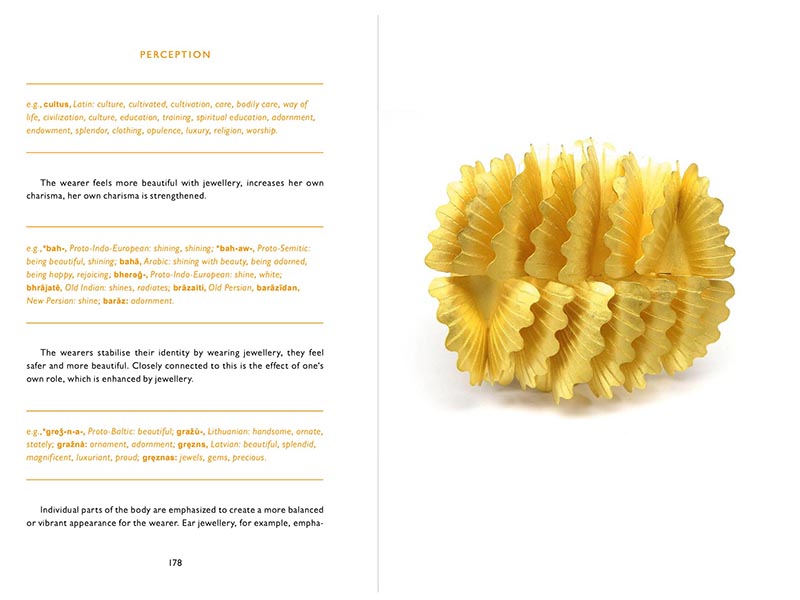
Differentiated by color and dividing lines in warm orange ink, etymological definitions sprinkle a different kind of knowledge throughout the text. These linguistic definitions support the discussions of the origins of the words, providing additional connections between languages, people, materials, and culture. Like the subheadings, these interruptions keep the text from getting unwieldy and are poetic in their sparse directness. In a discussion of the “innate and thus culture-independent” (page 69) human fascination with glitter, a statement backed up by behavioral psychologists, she introduces the word origin of “spark” and follows it from Czech to German to English. This linguistic definition supports the text’s discussion of humans’ fascination with light, specifically how it flashes on material surfaces, capturing our attention. Polished silver, copper, and gold; gemstones and pearls; and man-made materials like glitter all have the capacity to reflect light. In a sense, jewelry objects with these or similar materials capture light, briefly holding the brilliance of the sun. This chapter includes discussion of such words as luster, shimmer, shine, brilliance, dazzling, and illuminate in their relationship to jewelry and culture.
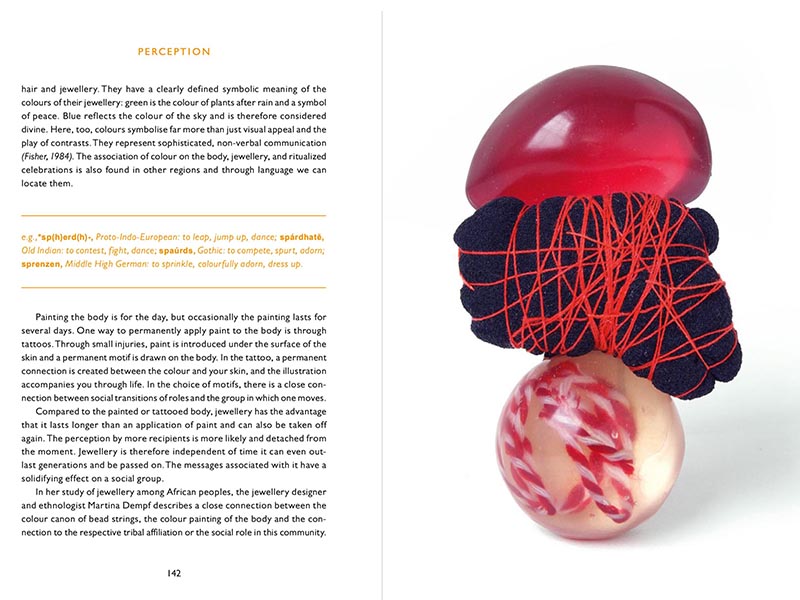
Which brings us to the most visually exciting element of this book: the jewelry. Interspersed throughout 350 Words for Jewellery are gorgeous, full-page color images of delightful jewelry. Selected exceedingly well and placed with care by Schmidt, each piece illustrates the discussion happening on the pages surrounding it. A bright red brooch by Beppe Kessler appears in the “Perception” chapter in a section about the symbolism of color; a brooch by Donna Brennan made of a variety of pearlescent materials echoes the conversation about light in the “Impact” chapter; and three pieces made of thread by Mari Ishikawa, Sayumi Yokouchi, and Mikiko Minewaki illustrate the “Composition” chapter with a focus on the spiritual power of the cord. The back of each illustrated page gives the artist’s name, a short artist statement that resonates with the text, and an image caption. These pieces are beautiful, object-based expansions of the text, taking the ideas and definitions into a materiality that leaps off the page.
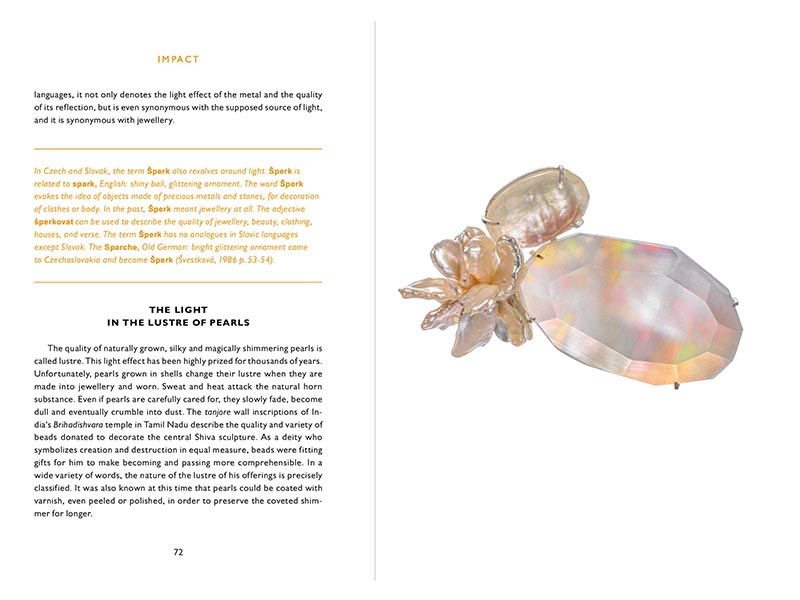
There are additional supplemental materials that may be of interest to the deep reader, including an alphabetical list of the 350 words studied that is 88 pages long and several pages of detailed references of both the print and online sources. Printed on orange paper that correlates with the linguistic definitions placed within the text, these are great resources for jewelry aficionados titillated by the ideas in the book. Strangely missing, however, is a listing of the 28 artists included in the text. For this particular audience, which is, presumably, more visually- or object- oriented, a reference page to find a specific brooch would be helpful.

While 350 Words for Jewellery isn’t a summertime, beach-vacation type of read, it is an excellent introduction to many of the reasons that jewelry captivates us as humans. Those who read this book will be equipped with more ways to express what they like, why they like it, and what draws them to explore this culturally rich creative practice that defies easy definitions. The book also serves as a bridge to understand what artists who use jewelry as a medium are referencing with material choices, historic references, and cultural resonances in their work. The jewelry that so beautifully illustrates the ideas in 350 Words for Jewellery didn’t do so accidentally. Many of the artists who made these objects actively study the same anthropologists, psychologists, and theoreticians that Schmidt references in the book to explain the many ways jewelry, culture, and language intersect. Instead of writing dissertations, these artists put their cultural research into the objects they create. Through Schmidt’s merging of the expertise of people who study culture and behavior, whether academic or artistic, we can understand what we already know in our very being: jewelry is irresistible.
US-based readers interested in purchasing this book may contact Charon Kransen Arts for pricing and shipping. All other readers, contact Barbara Schmidt directly.
[i] 350 Words for Jewellery was translated from German using the British spelling “jewellery,” but AJF style uses the American “jewelry” when referring to ornament, while keeping original spellings in titles—hence the multiple spellings in this essay.
[ii] https://artjewelryforum.org/articles/what-is-it-that-you-do-exactly/




